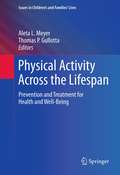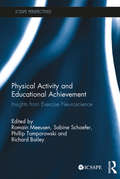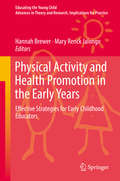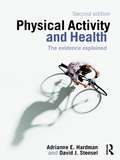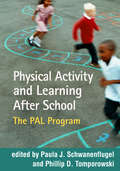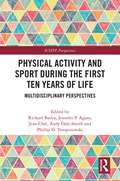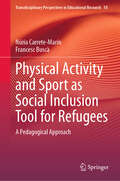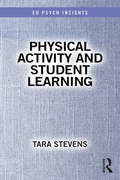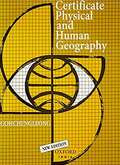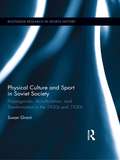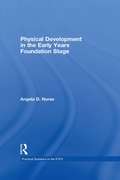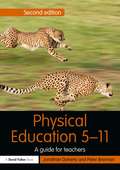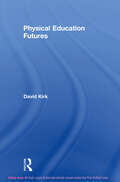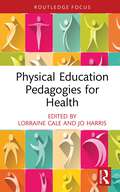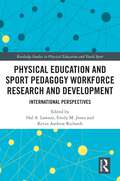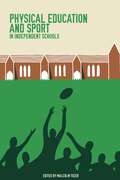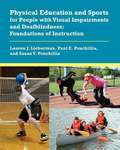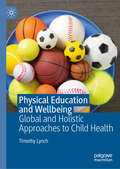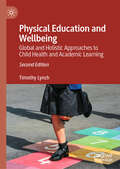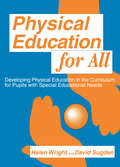- Table View
- List View
Physical Activity Across the Lifespan
by Thomas P. Gullotta Aleta L. MeyerThe statistics are disturbing: steadily rising numbers of sedentary overweight children and obese teens, and a generation looking at a shorter life expectancy than their parents'. But while it may be obvious that physical fitness benefits both the mind and body, a growing research base is supplying evidence of why this is so, and how these benefits may be reproduced in greater numbers. Physical Activity Across the Lifespan makes a clear, scientific case for exercise, sports, and an active lifestyle in preventing illness and establishing lifetime health habits at both the individual and the population levels. The book focuses on key aspects of physical/mental well-being--weight, mood, and self-regulation--and the role of physical activity in public health and school-based interventions targeting these areas. Contributors review definitional and measurement issues salient to understanding what physical activity is, to analyzing benefits of participation, and to implementing effective interventions. Also addressed are limitations of current research, steps needed to continue building the field, and emerging therapeutic possibilities for activity, such as the role of rough and tumble play in preventing ADHD. Included in the coverage: Physical activity, cognition, and school performance. The influence of social and built environments on physical activity in middle-aged and older adults. Preventing and treating obesity through physical activity. Physical activity in preventing drug use and treating chemical dependence. Antidepressant properties of physical activity. Schools as a foundation for physical activity and an active lifestyle. Physical activity as an adjunct or booster to existing interventions. Physical Activity Across the Lifespan is an innovative text for researchers and practitioners in various disciplines including health promotion/disease prevention, child and school psychology, education, health psychology, and public health, as well as program developers and policymakers in these areas.
Physical Activity and Educational Achievement: Insights from Exercise Neuroscience (ICSSPE Perspectives)
by Richard Bailey Romain Meeusen Sabine Schaefer Phillip TomporowskiA growing body of research evidence suggests that physical activity can have a positive effect on educational achievement. This book examines a range of processes associated with physical activity that are of relevance to those working in education – including cognition, learning, memory, attention, mood, stress and mental health symptoms – and draws on the latest insights from exercise neuroscience to help explain the evidence. With contributions from leading scientists and educationalists from around the world, this book cuts through the myths to interrogate the relationship between physical activity and educational achievement in children, adolescents and young adults in a variety of cultural and geographical contexts. Examining both the benefits and risks associated with physical activity from the perspectives of exercise science and educational psychology, it also looks ahead to ask what the limits of this research might be and what effects it might have on the future practice of education. Physical Activity and Educational Achievement: Insights from Exercise Neuroscience is fascinating reading for any student, academic or practitioner with an interest in exercise science and education.
Physical Activity and Health Promotion in the Early Years: Effective Strategies for Early Childhood Educators (Educating the Young Child #14)
by Mary Renck Jalongo Hannah BrewerThis book focuses on improving well-being among young children. It provides a theoretical base explaining why physical activity is important, and offers practical strategies for increasing health and well-being in early childhood settings. It takes ancient wisdom on the mind and body connection, applies it to the youngest children, and supports it with current empirical and international evidence—all with an eye toward improving wellness across the lifespan. The many topics discussed in the book include children’s motor skills, movement, interaction, physical literacy, the use of video games, dog ownership, developmental delays, as well as strategies to improve physical activities in the classroom and broader contexts. In recent years, children’s health has become a priority worldwide. Topics such as “screen time” “sedentary behavior” and “childhood obesity” have become important issues everywhere- in the news, in schools, in community and commercials settings, and among health care providers. Limiting sedentary behavior, increasing physical activity, and maintaining a nutritious diet are three fundamental needs during early childhood. Preschool years are a time when children begin to explore the world around them, and develop more vivid understandings of their surroundings. As this book shows, the early years may be the best time to teach wellness concepts and assist young children in establishing healthy lifestyle habits.
Physical Activity and Health: The Evidence Explained
by Adrianne E. Hardman David J. StenselPhysical Activity and Health explains clearly, systematically and in detail the relationships between physical activity, health and disease, and examines the benefits of exercise in the prevention and treatment of a wide range of important conditions. Now in a fully updated and revised edition, and still the most complete and engaging textbook on this important subject, Physical Activity and Health offers a balanced examination of the very latest evidence linking levels of physical activity with disease and mortality. It offers a wide-ranging assessment of the importance of inactivity as a factor in major diseases and health conditions such as cardiovascular disease, diabetes, obesity, cancer and osteoporosis. The book is designed to help the reader evaluate the quality and significance of the scientific evidence, and includes an invaluable discussion of common study designs and the inherent difficulties of measuring physical activity. It also explores the full range of contemporary themes in the study of exercise and health, such as the hazards of exercise; exercise and the elderly; children’s health and exercise; physical activity and public health policy; and a critical appraisal of current recommendations for physical activity. Containing useful features throughout, such as chapter summaries, study tasks, guides to supplementary reading and definitions of key terms, and richly illustrated with supporting tables, figures and plates, Physical Activity and Health is an essential course text. Now supported by a companion website featuring self-test questions, PowerPoint slides for lecturers, additional learning activities and web links, this book is vital reading for degree-level students of sport and exercise science, public health, physical therapy, medicine and nursing. Visit the companion website for Physical Activity and Health at www.routledge.com/textbooks/9780415421980.
Physical Activity and Learning After School: The PAL Program
by Paula J. Schwanenflugel Phillip D. TomporowskiEvery school day, more than 10 million children attend after-school programs in the United States. This book provides a research-based blueprint for offering students in grades 1-5 innovative programming that combines intensive physical activity and social-emotional skills development with academic enrichment in reading, mathematics, and social studies. Presented is an integrative approach that has been developed and tested in high-poverty schools. The volume includes explicit guidance for setting up a program, implementing cognitively engaging physical games and learning activities, working effectively with mixed-age groups, and monitoring outcomes. Reproducible forms and lesson plans can be downloaded and printed in a convenient 8 1/2" x 11" size.
Physical Activity and Sport During the First Ten Years of Life: Multidisciplinary Perspectives (ICSSPE Perspectives)
by Bailey RichardEvidence suggests that the first 10 or so years of life create the foundation for subsequent participation in recreational and health-related physical activity. This book brings together researchers and practitioners with expertise in issues related to physical activity, physical education, and sport during the primary/elementary phase of schooling, to explore these important issues. Combining inter-disciplinary perspectives, the book addresses the inherent complexity of researching with young children. It looks at the evidence on development during the first 10 years and how that evidence relates to physical activity and to sport, in pre-school, school and out of school. Finally, the book offers a series of national case studies, from Asia, Europe and Africa, demonstrating the importance of age-appropriate sport and physical activity. This is important reading for any student, researcher, educator or policy maker with an interest in physical activity and health, education in the early years or at primary/elementary level, paediatric exercise science, or youth sport.
Physical Activity and Sport as Social Inclusion Tool for Refugees: A Pedagogical Approach (Transdisciplinary Perspectives in Educational Research #10)
by Núria Carrete-Marín Francesc BuscàThis book addresses the social benefits of physical activity and sport in promoting the social and educational inclusion of refugees living in Europe in line with Sustainable Development Goals 4, 10 and 16. It provides a theoretical framework supported by evidence obtained from a case study in the Spanish context. The book demonstrates how universities and formal and non-formal educational institutions, by means of service-learning activities managed by physical and social educators, enable refugees and students to practice physical activity, develop further learning and establish stable social networks. It shows how a pedagogical approach to physical activity can improve relationships between students and refugees and promote inclusion of all. It discusses the value of diversity in education and educational research, as well as transdisciplinarity in new educational and research approaches.
Physical Activity and Student Learning (Ed Psych Insights)
by Tara StevensDiscussions of physical activity in schools often focus on health-related outcomes, but there is also evidence for its integral role in academic achievement, cognition, and psychological adjustment. Written by a scientist-practitioner, Physical Activity and Student Learning explores the effects of physical activity within the broader context of educational psychology research and theory and brings the topic to a wider audience. With chapters on positive school behavior, executive function, and interventions, this concise volume is designed for any educational psychology or general education course that includes physical activity in the curriculum. This book establishes physical activity as an important part of all learning—not just physical education and recess—and will be indispensable for student researchers and both pre- and in-service teachers alike.
Physical Culture and Sport in Soviet Society: Propaganda, Acculturation, and Transformation in the 1920s and 1930s (Routledge Research in Sports History Series #2)
by Susan GrantFrom its very inception the Soviet state valued the merits and benefits of physical culture, which included not only sport but also health, hygiene, education, labor and defense. Physical culture propaganda was directed at the Soviet population, and even more particularly at young people, women and peasants, with the aim of transforming them into ideal citizens. By using physical culture and sport to assess social, cultural and political developments within the Soviet Union, this book provides a new addition to the historiography of the 1920s and 1930s as well as to general sports history studies.
Physical Development in the Early Years Foundation Stage (Practical Guidance in the EYFS)
by Angela D NurseThe Practical Guidance in the Early Years Foundation Stage series will assist practitioners in the smooth and successful implementation of the Early Years Foundation Stage. Each book gives clear and detailed explanations of each aspect of Learning and Development and encourages readers to consider each area within its broadest context to expand and develop their own knowledge and good practice. Practical ideas and activities for all age groups are offered along with a wealth of expertise of how elements from the practice guidance can be implemented within all early years settings. The books include suggestions for the innovative use of everyday ressources, popular books and stories. This book will both raise the awareness of readers to how physical development impacts on all areas of learning and general development. The author encourages practitioners to think about what physical activity actually means for children and the importance of balancing risk and challenge, providing opportunities for children to be active and interactive and to use their senses to learn about the world around them.
Physical Education 5-11: A guide for teachers (Primary 5-11 Series)
by Jonathan Doherty Peter BrennanPhysical Education 5-11 is about lighting or relighting a fire in all those who have the privilege and the responsibility of teaching children physical education in Primary schools today. It is written at a time of great change: a revised Primary curriculum; an increased drive to raise achievement and potentially a narrowing of curricular scope in favour of literacy and numeracy. It is little wonder that teachers are looking for certainty and answers to questions such as:- What do I teach in PE? What do I need to know about children’s development? What does good teaching look like in PE? How can I assess such a practical subject effectively? ? This new and updated edition provides answers to those questions, covers issues in Physical Education and provides a wealth of practical advice on teaching across the stages of the new 2014 curriculum. Drawing upon the author’s experiences as a teacher, coach, lecturer and adviser, it delivers a justification for PE as an essential element in the Primary curriculum, imbues a theory into practice approach that provides readers with clarity, instils confidence and offers a licence to teach all practical aspects of PE effectively and creatively underpinned by knowledge of children’s development, their learning and the critical professional issues in PE today. This book is the essential companion to inform and inspire students and practising teachers in this most dynamic and exciting of subjects!
Physical Education Futures (Routledge Studies in Physical Education and Youth Sport)
by David KirkCan we imagine a future in which physical education in schools no longer exists? In this controversial and powerful meditation on physical education, David Kirk argues that a number of different futures are possible. Kirk argues that multi-activity, sport-based forms of physical education have been dominant in schools since the mid-twentieth century and that they have been highly resistant to change. The practice of physical education has focused on the transmission of de-contextualised sport-techniques to large classes of children who possess a range of interests and abilities, where learning rarely moves beyond introductory levels. Meanwhile, the academicization of physical education teacher education since the 1970s has left teachers less well prepared to teach this programme than they were previously, suggesting that the futures of school physical education and physical education teacher education are intertwined. Kirk explores three future scenarios for physical education, arguing that the most likely short-term future is ‘more of the same’. He makes an impassioned call for radical reform in the longer-term, arguing that without it physical education faces extinction. No other book makes such bold use of history to interrogate the present and future configurations of the discipline, nor offers such a wide-ranging critique of physical culture and school physical education. This book is essential reading for all serious students and scholars of physical education and the history and theory of education.
Physical Education Pedagogies for Health (Routledge Focus on Sport Pedagogy)
by Lorraine Cale Jo HarrisThis book focuses on health within physical education (PE) and specifically on PE pedagogies for health. It gives practitioners and students the knowledge, understanding, skills and confidence to employ effective health pedagogies and practices in their work, and to promote healthy, active lifestyles within their PE curricula. Drawing on cutting-edge research, the book highlights key pedagogical issues and debates concerning the delivery of health in PE, and their implications for practice, such as in policy and curriculum development. It explores recent recommendations and developments in PE pedagogies for health which have been shown to enhance, or have the potential to enhance, practice in the area, as well as future opportunities for doing so. It provides practical tools that bridge the gap between research and application, including learning activities and questions that encourage the reader to reflect on their own professional practice and identify actions for developing their own pedagogy, practice and curricula in the area. This is essential reading for all PE teachers, coaches working with children or young people, teacher and coach educators, and trainee teachers and coaches.
Physical Education and Sport Pedagogy Workforce Research and Development: International Perspectives (Routledge Studies in Physical Education and Youth Sport)
by Hal A. Lawson Kevin Andrew Richards Emily M. JonesThis is the first book to examine physical education from the perspective of workforce research and development. It adopts a whole system approach—including schools, higher education and public policy—to advance an action‑oriented framework for meeting the needs, challenges and opportunities of the global physical education profession.Presenting a new framework for research and continuous improvement, this book focuses on the physical education workforce, and the workforce system, as a key social determinant of new program design and implementation, and therefore of better outcomes for children and young people. Including the voices of higher education faculty, in-service physical education practitioners and professional association leaders, this book explains how specialized workforce components such as teacher education, school programs, doctoral programs and public policy are inter‑related, and takes a close look at how a workforce R&D approach can shine new light on physical education across the globe, including in-depth case studies from North and South America, Europe, Asia and Oceania. The final section of this book presents comparative analysis, considers lessons learned and outlines an agenda, which will empower readers to participate in and lead workforce development initiatives.Combining practical guidance and thorough research, this book is fascinating reading for any advanced student, researcher, in‑service teacher or policymaker with an interest in physical education, coaching children in sport, teacher education, international education or education policy.
Physical Education and Sport in Independent Schools
by Malcolm TozerA collection of chapters investigating the important role played by PE and sport in independent schools, from contributors including former Olympic medallists Roger Black and Jonathan Edwards, Rugby World Cup winning coach Sir Clive Woodward and Baroness Campbell, Chair of UK Sport. Edited by Dr Malcolm Tozer, former director of PE and housemaster at Uppingham School.
Physical Education and Sport in Independent Schools
by Malcolm TozerA collection of chapters investigating the important role played by PE and sport in independent schools, from contributors including former Olympic medallists Roger Black and Jonathan Edwards, Rugby World Cup winning coach Sir Clive Woodward and Baroness Campbell, Chair of UK Sport. Edited by Dr Malcolm Tozer, former director of PE and housemaster at Uppingham School.
Physical Education and Sports for People with Visual Impairments and Deafblindness
by Lauren J. Lieberman Paul E. Ponchillia Susan V. PonchilliaPhysical education teachers, adapted physical education teachers, and activity leaders in the trenches are always on the lookout for new, appropriate, and appealing games and activities for their students. When it comes to working with individuals who are visually impaired or deafblind, however, most of them confront what may seem like a greater challenge: how to in¬clude these students in physical activities and adapt activities so that they may participate fully along with others. In Physical Education and Sports for People with Visual Impairments and Deafblindness: Foundations of Instruction, Lauren Lieberman, Paul Ponchillia, and Susan Ponchillia contribute compelling resources for these efforts and for these professionals, as well as for recreational therapists, physical therapists, teachers of students with visual impairments or deafblindness, and anyone concerned with the full inclusion of children and adults who are visually impaired in athletics and the other essential activities of life.
Physical Education and Wellbeing: Global and Holistic Approaches to Child Health
by Timothy LynchThis book explores how physical education (PE) can be best enacted in primary schools in order to optimise children’s wellbeing. Drawing together extensive data from school communities around the globe, the author examines multiple dimensions of child health in practice. Ultimately, the findings suggest that PE is imperative within the wider landscape of children’s holistic learning, offering a powerful platform for meaningful connections across learning areas. While quantitative research has long evidenced the benefits of physical activity, this book contributes to the complex and global issue of what effective health and wellbeing approaches look like in practice. It is natural for children to enjoy movement for the purposes of play, exploration, learning and development: this book is essential reading for educators looking to enhance children’s wellbeing and general health.
Physical Education and Wellbeing: Global and Holistic Approaches to Child Health and Academic Learning
by Timothy LynchThis book, now in its second edition, explores how physical education (PE) and learning through movement can be best enacted in schools in order to optimise children's wellbeing and subsequent academic learning. Drawing together extensive data from school communities around the globe, the author examines multiple dimensions of child health in practice. Ultimately, the findings suggest that PE is imperative within the wider landscape of children’s holistic learning, offering a powerful platform for meaningful connections across learning areas. While quantitative research has long evidenced the benefits of physical activity, this book contributes to the complex and global issue of what effective health and wellbeing approaches look like in practice, offering clear strategies for optimising children’s academic learning. It is natural for children to enjoy movement for the purposes of play, exploration, learning and development; this book is essential reading for scholars (professors, researchers and students), school leaders and educators looking to enhance children’s wellbeing, general health and academic learning.
Physical Education class 10 - Karnataka board: ದೈಹಿಕ ಶಿಕ್ಷಣ ವರ್ಗ 10 - ಕರ್ನಾಟಕ ಮಂಡಳಿ
by Karnataka Patyapusthaka SanghaPhysical Education text book for 10th Kannada Medium, Karnataka State
Physical Education class 7 - Karnataka Board: ದೈಹಿಕ ಶಿಕ್ಷಣ ವರ್ಗ 7 - ಕರ್ನಾಟಕ ಮಂಡಳಿ
by Karantaka Patya Pustaka SanghaIts an 7th Standard physical Education Text Book
Physical Education class 8 - Karnataka board: ದೈಹಿಕ ಶಿಕ್ಷಣ ವರ್ಗ 8 - ಕರ್ನಾಟಕ ಮಂಡಳಿ
by Karnataka Patyapusthaka SanghaPhysical Education Textbook for 8th Standard Kannada Medium, Karnataka State
Physical Education class 9 - Karnataka Board: ದೈಹಿಕ ಶಿಕ್ಷಣ ವರ್ಗ 9 - ಕರ್ನಾಟಕ ಮಂಡಳಿ
by Karanataka Patya Pustaka SanghaIts an 9th standard kannada medium Physical education Book .
Physical Education for All: Developing Physical Education in the Curriculum for Pupils with Special Difficulties (Entitlement For All Ser.)
by David A. Sugden Helen C. WrightFirst Published in 1999. Routledge is an imprint of Taylor & Francis, an informa company.
